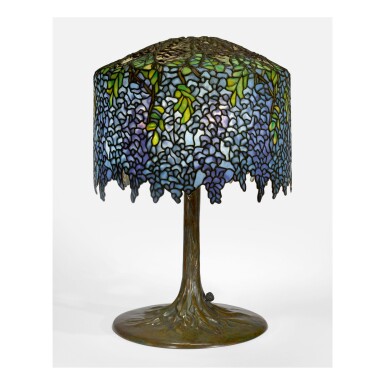
TIFFANY STUDIOS | "WISTERIA" TABLE LAMP
Auction Closed
October 7, 07:54 PM GMT
Estimate
300,000 - 500,000 USD
Lot Details
Description
Property of a Distinguished Collector
TIFFANY STUDIOS
"WISTERIA" TABLE LAMP
circa 1903-1915
with a "Tree" base
leaded glass, patinated bronze
base impressed TIFFANY STUDIOS/NEW YORK/342
27½ in. (69.9 cm) high
18¼ in. (46.4 cm) diameter of shade
Private Collection, acquired directly from Tiffany Studios, New York, 1921
Thence by descent
Christie's South Kensington, November 15, 1976, lot 211
Acquired from the above by the present owner
Dr. Egon Neustadt, The Lamps of Tiffany, New York, 1970, p. 215
Alastair Duncan, Tiffany At Auction, New York, 1981, pp. 89 and 148
William Feldstein, Jr. and Alastair Duncan, The Lamps of Tiffany Studios, New York, 1983, pp. 36-37
Alastair Duncan, Louis C. Tiffany: The Garden Museum Collection, Woodbridge, Suffolk, 2004, pp. 292-293
Martin Eidelberg, Alice Cooney Frelinghuysen, Nancy A. McClelland and Lars Rachen, The Lamps of Louis Comfort Tiffany, New York, 2005, pp. 106-107
Alastair Duncan, Tiffany Lamps and Metalware, Woodbridge, Suffolk, 2007, p. 67
Martin Eidelberg, Nina Gray and Margaret K. Hofer, A New Light on Tiffany: Clara Driscoll and the Tiffany Girls, London, 2007, p. 48
Designed in 1901 by Clara Driscoll, the “Wisteria” lamp quickly became one of the most successful models produced by Tiffany Studios. Its complex pattern is comprised of nearly 2,000 individually cut and selected glass tiles. As a result, each Wisteria lamp possesses its own distinct character and color palette, despite being a standard model. Technical aspects of the model evolved following its conception at the turn of the century. Early examples of the shade model, such as the present lot, feature a sharp shoulder, whereas later versions display a gentler curve descending from the upper bronze armature. The glass pattern of the model was also revised slightly over the years. The pattern of the present shade can be dated to 1903, while its "Tree" base appears to have been produced slightly later, around 1910-1915. In addition to its rich and artistic glass selection, this shade is further distinguished by the unusual execution of its cast bronze armature. While most Wisteria lamps include leaded glass between the bronze branches of the armature, here some of those spaces are left open. The effect is incredibly dynamic and is an indication of this shade’s early production and likely experimental production.
